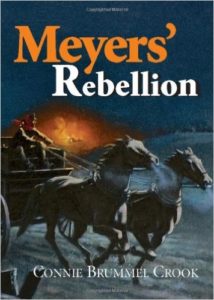For awards, reviews, excerpts and other information please scroll down.

Publisher: Markham: Fitzhenry & Whiteside, 2006.
Cover Art: David Craig
Summary: The third in the Meyers saga, is centred around John, a fifteen-year-old grandson of John W. Meyers, founder of Belleville, Ontario. Back in 1837, nothing is simple and things get ugly when John finds himself embroiled in the Upper Canada Rebellion under the leadership of the fiery William Lyon Mackenzie himself. Though their father Jacob tries to stop it, one by one all the Meyers boys throw their support on the Reformers’ side. With pretty Nan Burditt’s help, John is able to follow his brothers to a small island in Canadian/US waters, the site of another rebels’ skirmish. On the side, he’s always on the lookout for the legendary Silver Cave – for which a few Meyers have already lost their lives.
AWARDS
Novel Award by The Word Guild 2007
One of five Finalists in ’07 for Geoffrey Bilson Historical Fiction Award
REVIEWS
In 1837, John Meyers is a 15-year-old in Toronto on market day for the first time. While exploring the city, he becomes caught up in a protest led by William Lyon Mackenzie, whom he defends from violent thugs; this chance meeting embroils our protagonist in the unsuccessful Upper Canada Rebellion. Grappling with the complicated politics of the rebellion, John is initially ignorant and ambivalent about Mackenzie and his gang, a position that allows the novel to explain a great deal of this relatively unknown history to the reader.
John’s brothers turn out to be rebels while his father is a staunch Loyalist. John’s decision to join the rebellion is thus a significant part of his coming of age, a theme further developed by his deepening affection for his friend Nan . . . . Meyers’ Rebellion avoids the potentially soapy aspects of these subplots, using them to add humanity and humour to the characters without detracting from the otherwise straightforward historical narrative.
Ontario writer Connie Brummel Crook has written several books, including two – Flight and Meyers’ Creek – inspired by the real-life Meyers clan – to whom she is related. Her experience with historical fiction allows her to incorporate significant research without becoming pedantic. The result is a solid, accessible, and enjoyable tale that will likely find its best fit in a classroom or library, where it will enliven and illuminate this significant epoch for readers. . . .
– Former bookseller Laurie McNeill, a research fellow with a doctorate in Canadian autobiography in July/August 2006 Quill & Quire, p.68.
EXCERPTS
John looked at Clancy. Then he looked at Gibson. Did they think he was some sort of fool? It was getting more and more obvious that George was mixed up with some rebellion business.
For their part, Clancy and Gibson looked at each other the way his parents did sometimes—as if they were trying to figure out how to tell him something they didn’t want to.
“Well, since you’re in the middle of all of this now…” Gibson said very carefully. Then he stopped himself. “But first, let’s decide how we’re going to get George out of trouble.”
“Oh, don’t worry, sir,” said John, as coldly as he could. “I’ll go and get him out of jail. Just tell me where it is.”
“I’m afraid it’s no job for a boy,” said Mr. Gibson.
Connie Brummel Crook knows how to tell a good story. She would be a wonderful person to have in the family because of the skilled manner in which she takes her family history and crafts it into an exciting, informative read. Meyers’ Rebellion is the third historical fiction novel in a series of books detailing Crook’s family history. In Flight, Crook detailed the activities of her great, great, great, great, great grandfather, Hans Waltermyer—later known as John Meyers—fighting as a Loyalist during the American Revolution. In the sequel, Meyers’ Creek, Crook focused primarily on the life and love of Hans’ daughter, Mary. In this third book, the tale centres on Hans’ grandson, 15-year-old, John Meyers.
One of the many strengths of Crook’s writing is her ability to show, rather than to tell, what is happening. Good writing provides enough detail to stimulate the senses and show the reader what is going on. . . . This quality in Crook’s writing is exemplified through her treatment of John’s romantic interest in the neighbour, Nan Burditt. . . . Having said these things, John’s romantic aspirations are but a subplot to what is an exciting action adventure. The political unrest in and around Toronto in 1837 and 1838 is at the heart of this drama. Given the Meyers’ Loyalist roots, Crook presents a delicious tension between the loyal patriotic family traditions and the growing unrest at the so-called Family Compact network of officials who dominated the government and controlled the distribution of patronage throughout Upper Canada. Eventually, most of the Meyers’ family joins the side of the Reformers, and John and his brothers become involved in rebellion. . . .
Historical fiction doesn’t necessarily engender a great deal of enthusiasm from teenage readers. Despite this, I think that high school Canadian history teachers would do well to direct their students toward Connie Brummel Crook. As a relatively new arrival to this country, I have learned a great deal about Canada’s historical roots through reading the Meyers series.
. . .
I am one reader who certainly hopes that the series has not yet come to an end. I expect that Connie Brummel Crook has far too many interesting family history stories to share for her to end just yet.
Copyright © the Manitoba Library Association.
Written by Gregory Bryan, who teaches literacy education classes at University of Manitoba. This review is quoted from CM materials, the Manitoba Library Association, University of Manitoba, Winnipeg, MB.